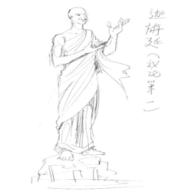翼龍既詳細資料in eng
2013-06-18 2:37 am
please very urgent!!
回答 (2)
2013-06-18 1:24 pm
✔ 最佳答案
Pterosaurs (/ˈtɛrɵsɔr/, from the Greek πτερόσαυρος, pterosauros, meaning "winged lizard") were flying reptiles of the clade or order Pterosauria. They existed from the late Triassic to the end of the Cretaceous Period (220 to 65 million years ago). Pterosaurs are the earliest vertebrates known to have evolved powered flight. Their wings were formed by a membrane of skin, muscle, and other tissues stretching from the ankles to a dramatically lengthened fourth finger.Early species had long, fully toothed jaws and long tails, while later forms had a highly reduced tail, and some lacked teeth. Many sported furry coats made up of hair-like filaments known as pycnofibres, which covered their bodies and parts of their wings. Pterosaurs spanned a wide range of adult sizes, from the very small Nemicolopterus to the largest known flying creatures of all time, including Quetzalcoatlus and Hatzegopteryx.Pterosaurs are often referred to in the popular media and by the general public as flying dinosaurs, but this is incorrect. The term "dinosaur" is restricted to just those reptiles descended from the last common ancestor of the groups Saurischia and Ornithischia (clade Dinosauria, which includes birds), and current scientific consensus is that this group excludes the pterosaurs, as well as the various groups of extinct marine reptiles, such as ichthyosaurs, plesiosaurs, and mosasaurs. Pterosaurs are also incorrectly referred to as pterodactyls, particularly by journalists. "Pterodactyl" refers specifically to members of the genus Pterodactylus, and more broadly to members of the suborder Pterodactyloidea.
參考: 英文版維基百科 http://en.wikipedia.org/wiki/Pterosaur
2013-06-21 8:24 pm
這是 University of California Museum of Paleontology 的一篇介紹翼龍的文章,應該頗有參考價值,希望幫到你。
The genus Pteranodon includes several species oflarge pterosaurs from the Cretaceous period in North America. As you can tellfrom this photo, it had a large crested head, a huge wingspan (some 20-25 feet;the UCMP specimen is about 22 feet), and a comparatively small body. This isdeceiving; it looks like the head and wing bones were too bulky, and thehindlimbs appear small and weak. Not so; the bones of Pteranodon are actuallycompletely hollow (about 1 millimeter thick!), and were quite light. The wholeanimal probably weighed about 25 pounds, only slightly heavier than the largestflying birds. The hindlimbs are actually perfectly sized for the body;Pteranodon would have been capable of bipedal terrestrial movement (but was norapid runner, unlike its ancestors, some of whom seem to have been fast bipedalrunners). The wing bones look thick because a large bone diameter is more vitalfor resisting the bending stresses involved in flight (as opposed to large bonethickness, which is important for resisting compressive forces, such as thoseimposed by the weight of a large body), so actually the wings of Pteranodonwere more than adequate for flight. Pteranodon was almost certainly a soaring animal;it used rising warm air to maintain altitude; a common strategy among largewinged animals (among birds, albatrosses and vultures are adept at soaring).Its scoop like beak was used for snapping up fish as it soared over the oceansthat it nested by. A good modern analog for Pteranodon would be the pelican. The UCMP's mounted specimen of Pteranodon ingensis actually a composite specimen, pieced together from a few differentspecimens to form a complete one.
2013-06-21 12:28:23 補充:
這裏只 post 了文章的下半部分(字數限制),也沒有圖,所以最好上它的網看一看哦。
The genus Pteranodon includes several species oflarge pterosaurs from the Cretaceous period in North America. As you can tellfrom this photo, it had a large crested head, a huge wingspan (some 20-25 feet;the UCMP specimen is about 22 feet), and a comparatively small body. This isdeceiving; it looks like the head and wing bones were too bulky, and thehindlimbs appear small and weak. Not so; the bones of Pteranodon are actuallycompletely hollow (about 1 millimeter thick!), and were quite light. The wholeanimal probably weighed about 25 pounds, only slightly heavier than the largestflying birds. The hindlimbs are actually perfectly sized for the body;Pteranodon would have been capable of bipedal terrestrial movement (but was norapid runner, unlike its ancestors, some of whom seem to have been fast bipedalrunners). The wing bones look thick because a large bone diameter is more vitalfor resisting the bending stresses involved in flight (as opposed to large bonethickness, which is important for resisting compressive forces, such as thoseimposed by the weight of a large body), so actually the wings of Pteranodonwere more than adequate for flight. Pteranodon was almost certainly a soaring animal;it used rising warm air to maintain altitude; a common strategy among largewinged animals (among birds, albatrosses and vultures are adept at soaring).Its scoop like beak was used for snapping up fish as it soared over the oceansthat it nested by. A good modern analog for Pteranodon would be the pelican. The UCMP's mounted specimen of Pteranodon ingensis actually a composite specimen, pieced together from a few differentspecimens to form a complete one.
2013-06-21 12:28:23 補充:
這裏只 post 了文章的下半部分(字數限制),也沒有圖,所以最好上它的網看一看哦。
收錄日期: 2021-04-13 19:30:53
原文連結 [永久失效]:
https://hk.answers.yahoo.com/question/index?qid=20130617000051KK00314


